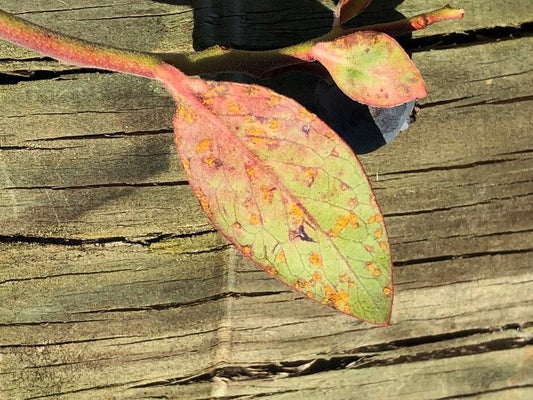
Quick facts
Common name - Blueberry rust
Scientific name - Pucciniastrum minimum (syn. Thekopsora minima)
Plants affected - Vaccinium spp. (blueberries) and Tsuga spp. (hemlocks)
Main symptoms - Spotting on the upper leaf surfaces and yellow-orange pustules on the lower leaf surfaces of blueberries
Caused by - Fungus
Timing - Leaf spots on blueberries during late summer and early autumn
What is blueberry rust?
Blueberry rust is a disease caused by the parasitic fungus Pucciniastrum minimum (syn. Thekopsora minima). It affects various members of the Ericaceae family, such as blueberries (Vaccinium spp.).
This fungus attacks both blueberries and hemlocks. In fact, it needs both plants in order to complete its full life cycle.
Survey
Seen blueberry rust? We would like to know.
As part of our research, the RHS would like to know where blueberry rust has been seen.
Please submit your records via our blueberry rust survey (expected time to complete survey = two minutes).
Thank you to everyone who has submitted records so far. Discover other sightings you can report to help our research here.

Symptoms
You may see the following symptoms:
- On blueberries: Spotting on the upper leaf surfaces, corresponding to yellow-orange pustules on the lower leaf surfaces. Infected leaves may turn brown and fall early, reducing the vigour of plants and sometimes leading to plant death of susceptible cultivars. Fruit quality might also be affected
- On hemlocks: Cylindrical cluster cups (aecia) on the underside of the needles (not yet seen in the UK)
Management
The RHS believes that avoiding pests, diseases and weeds by good practice in cultivation methods, selection, and encouraging or introducing natural enemies, should be the first line of control. If chemical controls are used, they should be used only in a minimal and highly targeted manner.
How do you treat rust on blueberries?
- Remove infected leaves as soon as they are detected, to prevent the spread of spores. Severely affected plants are best destroyed if other healthy blueberry plants are nearby
- Collect and destroy fallen leaves in autumn to reduce the number of overwintering resting spores
Fungicides
The RHS recommends that you don't use fungicides. Fungicides (including organic types) may reduce , impact soil health and have wider adverse environmental effects. If you do intend to use a fungicide, please read the information given in the links and download below to ensure that use, storage and disposal of the product is done in a responsible and legally-compliant manner.
The fungicides listed in the document that can be downloaded below are legally available for use by home gardeners in the UK. This information is provided to avoid misuse of legal products and the use of unauthorised and untested products, which potentially has more serious consequences for the environment and wildlife than when products are used legally. Homemade products are not recommended as they are unregulated and usually untested.
No fungicides are currently being produced for use by home gardeners on blueberry plants from which the fruit will be consumed.
Fungicides labelled for use on ornamental plants to control other rust diseases can be used on ornamental Vaccinium species (provided the fruit are not intended for consumption) and may provide some incidental control. They are used at the owner’s risk (test-spray a small area first to ensure that plant damage does not occur), but are safe to the operator when used as directed.
Download
Fungicides for gardeners (Adobe Acrobat pdf document outlining fungicides available to gardeners)
Link
Biology
The fungus causing blueberry rust is, like all rusts, a biotroph: it infects the host tissues for extended periods without killing them, feeding from the living cells. Rusts are not able to feed from dead plant material, so must either alternate with a different, host, or produce a resting spore to survive the season.
Blueberry rust alternates between blueberries and hemlocks (Tsuga spp.). The symptoms on blueberry leaves appear during late summer and autumn.
During its life cycle, Pucciniastrum minimum releases asexual spores (urediniospores) which can re-infect its ericaceous hosts (blueberries) multiple times during favourable conditions, e.g. high . Resting (winter) spores of Pucciniastrum minimum are formed and overwinter on leaves of blueberry or other plants of the Ericaceae family.
These spores germinate in the spring to produce reproductive spores (basidiospores) that can infect its alternate host, hemlock (Tsuga spp.). Airborne spores (aeciospores) are then formed on hemlock in early summer to infect newly emerging blueberry leaves. However, infections on hemlock have not yet been seen in the UK. It is thought that here the pathogen is able to survive season to season without infecting hemlock and therefore not completing its full life cycle.






